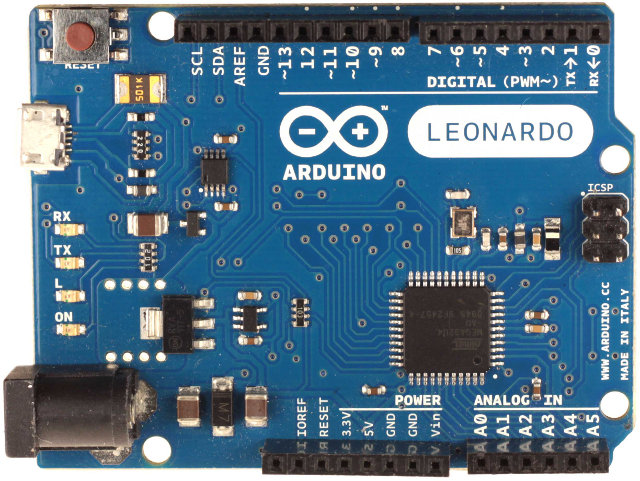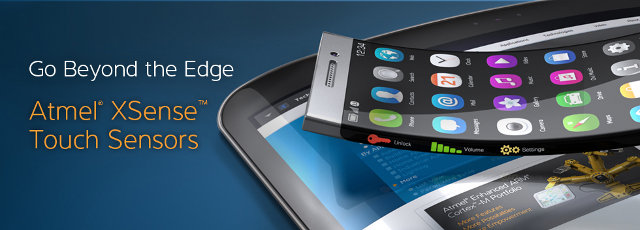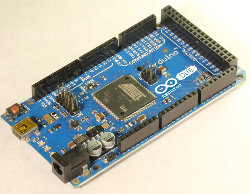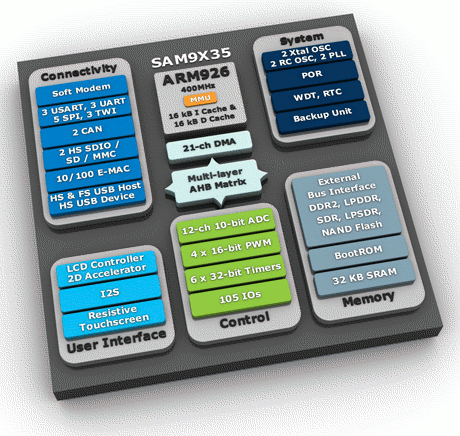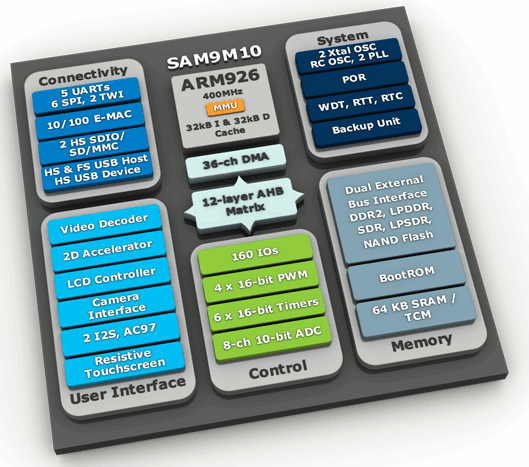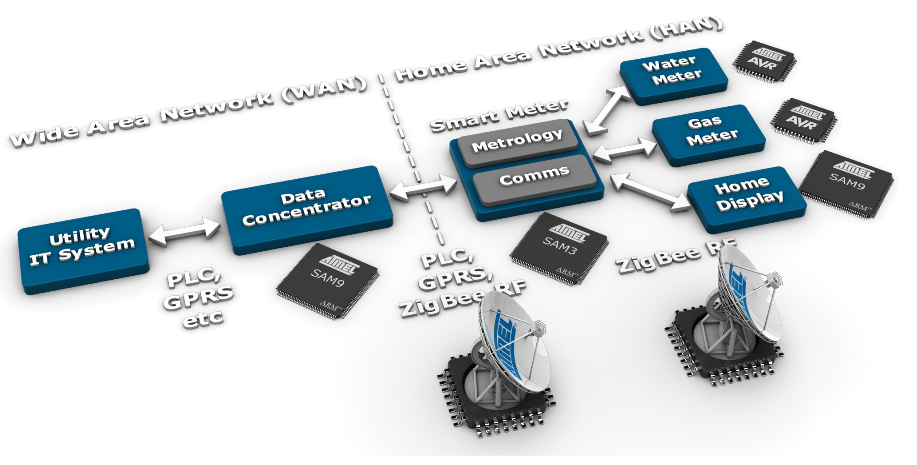Arduino Leonardo is a new Arduino board with a 16 MHz Atmega32U4, 2.5KB RAM, 32 KB of Flash memory, 20 digital I/O, 12 analog inputs and 7 PWM outputs. In this version the MCU takes care of USB communication with the host, whereas for Arduino Uno, a separate chip is required to take care of this, which makes Arduino Leonardo cheaper than Uno. Here’s a summary of Arduino Leonardo specifications: Microcontroller – Atmel ATmega32u4 @ 16 MHz SRAM – 2.5 KB onchip (ATmega32u4) Flash Memory – 32 KB onchip (ATmega32u4) of which 4 KB used by bootloader EEPROM – 1 KB onchip (ATmega32u4) Operating Voltage – 5V Input Voltage – (recommended) 7-12V | (limits) 6-20V Digital I/O – 20 pins PWM – 7 channels Analog Input – 12 channels DC Current per I/O Pin – 40 mA DC Current for 3.3V Pin – 50 mA Watch the video to get […]
Atmel Unveils AVR XMEGA C, tinyAVR ATtiny1634 and AVR UC3 L3/D4 MCUs
Atmel announced 14 new Atmel AVR microcontrollers divided into 4 families: AVR XMEGA C, tinyAVR ATtiny1634, AVR UC3 L3 and AVR UC3 D4. Atmel AVR XMEGA C MCUs Atmel AVR XMEGA C MCUs are 8-/16-bit general-purpose MCUs with Full-Speed USB, 12-bit ADC, up to 384 KB flash and 32 KB SRAM. They can support Atmel QTouch Library for implementation of capacitive buttons, sliders and wheels functionality. The AVR XMEGA C MCUs consume 700nA in sleep mode with RTC. There 8 new XMEGA C MCUs which target consumer, industrial and home automation applications such as thermostats with display, building and climate control, utility meters with RF and ZigBee connectivity. The smallest XMEGA C MCU (ATxmega16C4), which comes in 44-pin package and has 16KB device, is the cheapest AVR XMEGA device with USB provided by Atmel. You can find further information on Atmel AVR XMEGA C page. Atmel tinyAVR ATtiny1634 MCU Atmel […]
Atmel Unveils XSense Flexible Touch Sensors
Atmel has unveiled XSense, a flexible film-based touch sensor that allows the design of curved capacitive touch screen displays. Atmel expects target applications to go beyond smartphones and tablets, and extend touch capabilities into a wide array of new consumer and industrial products such as watches, coffee machines, calculators and more. XSense touch sensors, based on a proprietary roll-to-roll metal mesh technology, will allow OEMs to develop larger, lighter, sleeker, curved and edgeless designs for smartphones, tablets, ultrabooks and a host of new touch-enabled products, says the company. XSense sensors can be combined with Atmel maXTouch controllers which are already used in numerous smartphones and tablets such as the Samsung Galaxy Note and Samsung Galaxy Tab, as well as other touch controllers available on the market. Here are the key benefits of XSense technology: Flexibility for curved surfaces Narrow border for larger active screen areas Highly accurate stylus performance (active […]
Ronetix announces Five New Atmel SAM9 CPU Modules
Ronetix announced 5 CPU modules based on Atmel AT91SAM9 series: SAM9G35-CM – populated with AT91SAM9G35 SAM9G25-CM – populated with AT91SAM9G25 SAM9G15-CM – populated with AT91SAM9G15 SAM9X35-CM – populated with AT91SAM9X35 SAM9X25-CM – populated with AT91SAM9X25 Those 5 mew modules correspond to the 5 New Atmel processors and Devkit announced in August 2011. All modules offer 400MHz performance, 128MB to 256MB DDR2 SDRAM, 256MB NAND flash and 4MB to 8MB SPI flash. Here’s a comparison table of the different features available on the 5 modules / processors. Features SAM9G15 SAM9G35 SAM9X35 SAM9G25 SAM9X25 EMAC – RMII RMII MII MII + RMII ADC channels 12 12 12 7 7 CAN – – y – y 5-wires touchscreen y y y – – LCD y y y – – ISI – – – y – additional USART3 – – – y y The modules support the operating supported by SAM9 processors namely Android, […]
First ARM-Based Arduino Board with Atmel SAM3U
Arduino announced Arduino Due board with a 32bit Cortex-M3 ARM processor on their blog before Maker Faire. The SAM3U processor from ATMEL runs at 96MHz with 256Kb of Flash, 50Kb of SRAM, 5 SPI buses, 2 I2C interfaces, 5 UARTS, 16 Analog Inputs at 12Bit resolution and more. Contrary to previous hardware release, they intend to open the process to the community early on and they plan to to be demo the board and give away some boards to a selected group of developers who will be invited to shape the platform while it’s been created. After Maker Faire, a small batch of Developer Edition boards on the Arduino store will be sold to members of the community who want to join the development effort. The final board will be released by the end of 2011. If you can’t wait there are some other Arduino-like projects with Cortex-M3 support based […]
5 New Atmel SAM9 Processors: SAM9G15, SAM9G25, SAM9G35, SAM9X25, and SAM9X35
Atmel recently announced five new embedded processors for its SAM9 family all running at 400MHz, featuring 100mW consumption, support for DDR2 and NAND flash memory, with some models offering LCD touchscreen support and CAN interfaces: SAM9G15 based on ARM926EJ Embedded Microprocessor Unit with LCD, Touchscreen, HS USB and LPDDR/DDR2/MLC NAND support. SAM9G25 based on ARM926EJ Embedded Microprocessor Unit with Ethernet, HS USB and LPDDR/DDR2/MLC NAND support. SAM9G35 based on ARM926EJ Embedded Microprocessor Unit with LCD, Touchscreen, Ethernet, HS USB and LPDDR/DDR2/MLC NAND support. SAM9X25 based on ARM926EJ Embedded Microprocessor Unit with Dual Ethernet, Dual CAN, HS USB and LPDDR/DDR2/MLC NAND support. SAM9X35 based on ARM926EJ Embedded Microprocessor Unit with LCD, Touchscreen, Ethernet, Dual CAN, HS USB and LPDDR/DDR2/MLC NAND support. The 3 new SAM9G processors are basically a lower cost version of the SAM9G45 with less cache, no video decoding support, etc… The 2 SAM9X processors are similar but feature […]
Resources for Atmel AT91SAM9: SAM926X, SAM9GXX, SAM9M1X, SAM9XE…
Atmel AT91SAM9 – or simply Atmel SAM9 – series are versatile microcontrollers and embedded microprocessors used in variety of products such as internet radios, embedded p2p downloaders, smart grid in-home displays, and much more. Atmel SAM9 series are divided into five subsets: The original SAM9 MCU based on ARM926EJ-S running at between 210 and 240 Mhz, namely AT91SAM9260, AT91SAM9261, AT91SAM9261S and AT91SAM9263 SAM9G eMPU (Embedded MPU) based on ARM926EJ-S, a new generation based on SAM9 MCU architecture but running at between 266 and 400Mhz: AT91SAM9G10, AT91SAM9G20, AT91SAM9G45 and AT91SAM9G46. SAM9M eMPU based on ARM926EJ-S clocked at 400Mhz and with a video decoder: AT91SAM9M10 and AT91SAM9M11 SAM9R MCU based on ARM926EJ-S running at 210 Mhz with similar characteristic as the original SAM9 MCU, except it does not support USB Host but can be used as a High Speed USB device: AT91SAM9R64 and AT91SAM9RL64 SAM9XE MCU are also based on ARM926EJ-S running […]
In-Home Displays for Smart Grid – Atmel – Mentor Embedded
I’ve just attended a webinar organized by Mentor Graphics entitled “In-Home Displays: Enabling Smart Grid into every home” with Atmel and Mentor Embedded. This webinar is now available on-demand at http://go.mentor.com/hAz8 This webinar is divided into 2 parts: Frederic Gaillard – Product Marketing Manager at ATMEL – gave an overview of Smart Grid and its different components and presented Atmel Solutions: MCU/MPU, wireless chips (Zigbee/Wi-Fi) and touch screen chipset. Gordon Cameron – Business Development Manager at Mentor Embedded – focused on the difficulties in developing a user interface for In-Home Displays within a short time frame and how Mentor Embedded UI design solution Inflexion could help greatly reduce the development schedule. There was no external files for this webinar, so I created 2 PDF with the most relevant slides for your reference: Atmel Smart Grid and In-Home Displays Mentor Embedded In-Home Displays UI Development Tools Frederic Gaillard shortly explained the […]


